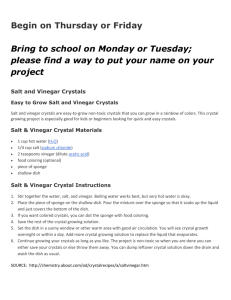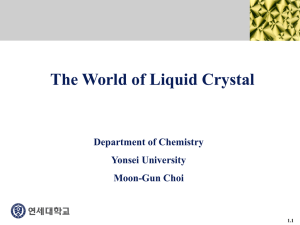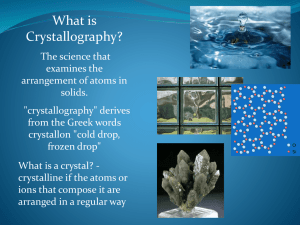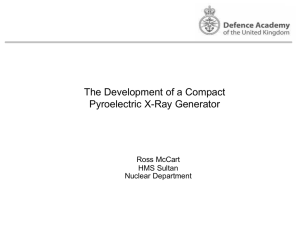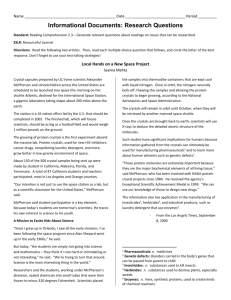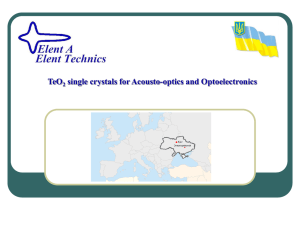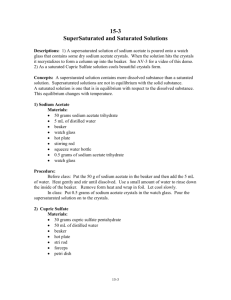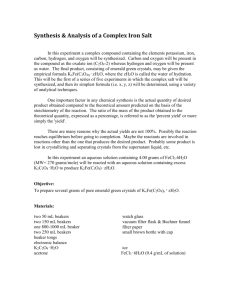STEM-Science-Growing-Crystals
advertisement
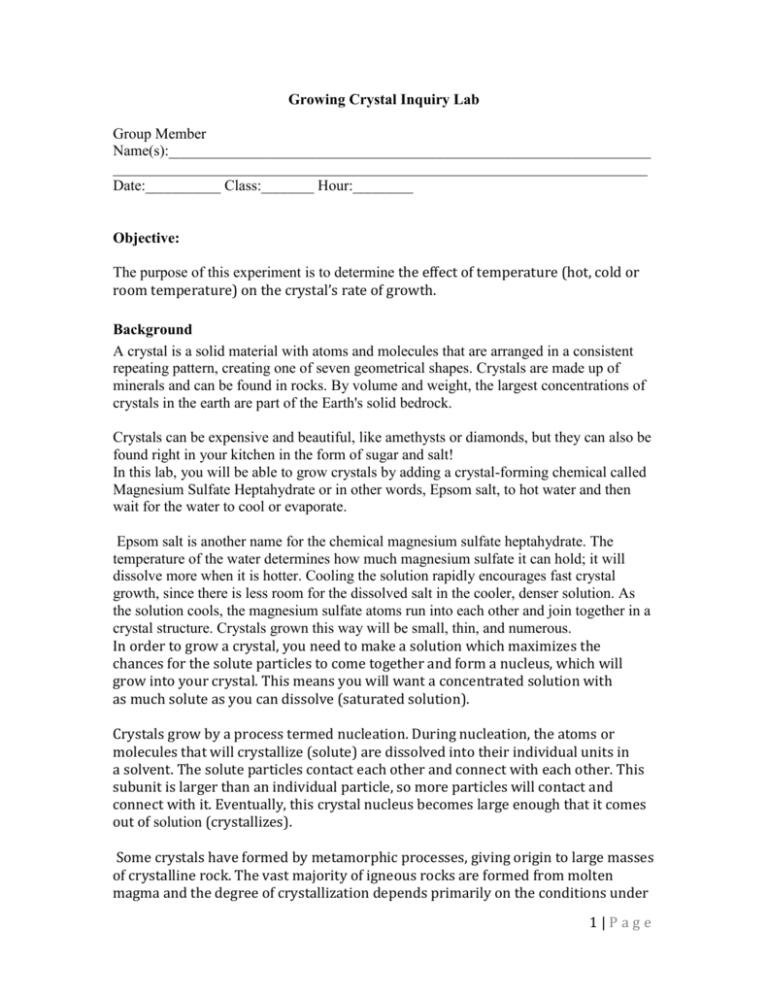
Growing Crystal Inquiry Lab Group Member Name(s):________________________________________________________________ _______________________________________________________________________ Date:__________ Class:_______ Hour:________ Objective: The purpose of this experiment is to determine the effect of temperature (hot, cold or room temperature) on the crystal’s rate of growth. Background A crystal is a solid material with atoms and molecules that are arranged in a consistent repeating pattern, creating one of seven geometrical shapes. Crystals are made up of minerals and can be found in rocks. By volume and weight, the largest concentrations of crystals in the earth are part of the Earth's solid bedrock. Crystals can be expensive and beautiful, like amethysts or diamonds, but they can also be found right in your kitchen in the form of sugar and salt! In this lab, you will be able to grow crystals by adding a crystal-forming chemical called Magnesium Sulfate Heptahydrate or in other words, Epsom salt, to hot water and then wait for the water to cool or evaporate. Epsom salt is another name for the chemical magnesium sulfate heptahydrate. The temperature of the water determines how much magnesium sulfate it can hold; it will dissolve more when it is hotter. Cooling the solution rapidly encourages fast crystal growth, since there is less room for the dissolved salt in the cooler, denser solution. As the solution cools, the magnesium sulfate atoms run into each other and join together in a crystal structure. Crystals grown this way will be small, thin, and numerous. In order to grow a crystal, you need to make a solution which maximizes the chances for the solute particles to come together and form a nucleus, which will grow into your crystal. This means you will want a concentrated solution with as much solute as you can dissolve (saturated solution). Crystals grow by a process termed nucleation. During nucleation, the atoms or molecules that will crystallize (solute) are dissolved into their individual units in a solvent. The solute particles contact each other and connect with each other. This subunit is larger than an individual particle, so more particles will contact and connect with it. Eventually, this crystal nucleus becomes large enough that it comes out of solution (crystallizes). Some crystals have formed by metamorphic processes, giving origin to large masses of crystalline rock. The vast majority of igneous rocks are formed from molten magma and the degree of crystallization depends primarily on the conditions under 1|Page which they solidified. Such rocks as granite, which have cooled very slowly and under great pressures, have completely crystallized; but many kinds of lava were poured out at the surface and cooled very rapidly, and in this latter group a small amount of amorphous or glassy matter is common. Other crystalline rocks, the metamorphic rocks such as marbles, mica-schists and quartzites, are recrystallized. Pre-lab Directions: Watch a video on growing crystals posted on the iblog. Then define the terms below and answer pre-lab questions using the textbook glossary, lab’s background information (provided above), and/or online resources. Saturated: Solution: Solvent: Solute: Crystal: Rock: Mineral: Metamorphic Rock: Igneous Rock: Sedimentary Rock: Pre-lab Questions: 1. How much hot water and magnesium will your group be mixing together to make a saturated solution? 2. Why is the hot water used instead of cold water to dissolve the Epsom salt? 3. How do you think that water will evaporate the best? 2|Page 4. How do you think the crystals are formed? 5. What do you think will happen if we keep a constant amount of water and increase the amount of salt? Decrease the amount of salt? 6. About how long, in terms of days, will it take for the crystals to form? Bellwork: Get with your group and compare answers from your pre lab. Revisit your hypothesis and make changes if needed. Label your Petri dish using a marker (Name initials and class hour) Fill out Jobs for Group Members: 1. Writer/ Petri dish Label creator & holder: _______________________________________ 2. Stirrer of Epsom Salt and Water: _________________________________________________ 3. Water Measurer & Timer: _________________________________________________________ Hypothesis My hypothesis is that crystals will grow faster _______________ temperature rather than in ______________ temperature due to ________________________________________________________ ________________________________________________________________________________________________. I believe the water in the saturated solution will evaporate faster by _________________________________________________________ due to __________________________________________________________________________________. Lab Safety Caution: Epsom salt or Magnesium Sulfate Heptahydrate may cause eye, skin, and respiratory tract irritation as the toxicological properties of this material have not been fully investigated. Therefore, please avoid smelling the chemical product and wear gloves and safety goggles while working on the experiment. 3|Page Use oven mitts to measure the hot water from a larger beaker to the graduated cylinder and when transferring from the graduated cylinder to the smaller sized beaker of 150ml. Procedure: 1. Make sure your Petri dish is labeled with your group #, name initials, and hour 2. Place black construction paper, which has been pre-cut in a circle, on the bottom of the petri dish 3. Once you are at the lab station, use the graduated cylinder to measure 15ml of the hot water from the larger beaker, which is placed on the hot plate. Lab Safety Caution: Use oven mitts to transfer water from 500- 300ml beaker to the graduated cylinder. 4. Transfer the water from graduated cylinder to the smaller beaker. 5. Put 7.4 grams or ½ tablespoon of Magnesium Sulfate into the smaller beaker with water 6. Use stirring rod to mix the saturated solution for 2 minutes 7. Pour the saturated solution on top of the black construction paper in the petri dish. Caution: Be careful when pouring the hot saturated solution of water and salt into the petri dish. 4|Page 8. Place it back in the cart to either place it in the window sill for sunlight (warm temperature), keep it in the classroom (room temperature), or inside the refrigerator (cold temperature). This will lead to the evaporation of the water, resulting in lots of crystal spikes on the black construction paper. 9. After couple of days (2-3days), observe the formation of crystals. 10. Collect and record data in terms of how many days did it take for crystals to form and at what temperature did the crystal grew the fastest. 11. Lastly, work on post- analysis questions and write a lab report using the rubric provided. Materials 1 Stirring rod (glass or wooden) 1 Graduated Cylinder 1 Small beakers of 150 ml Hot plates/ Electric Kettle Petri Dish Sharpie Marker (to label petri dish) 1/2 tbsp. or 7.5 g of Magnesium Sulfate Heptahydrate (Epsom Salt) 1 tbsp. or 15ml of hot water Gloves Safety Goggle Post Lab Analysis Questions How are the crystals formed? How long did it take for the crystals to form and why? 5|Page What temperature did the crystal grew the fastes and why? What are rocks? How are they formed? What is the relationship between rocks, minerals and crystals? What are igneous, metamorphic, and sedimentary rocks? How do you think the lab design can be improved? Reference: http://www.selah.k12.wa.us/soar/sciproj2000/kaitlyns.html 6|Page

